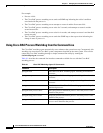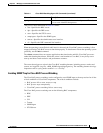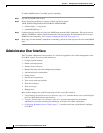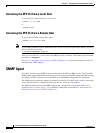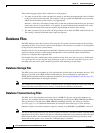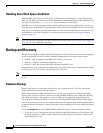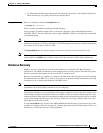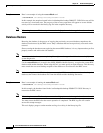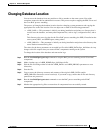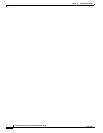
10-2
Cisco Broadband Access Center 3.8 Administrator Guide
OL-27172-01
Chapter 10 Database Management
Database Files
Write-ahead logging requires these conditions to work properly:
• You must set up the file system and physical storage so that they guarantee that the data is flushed
to physical storage when requested. For example, a storage system with SDRAM-only write cache,
which loses data during system failure, is not appropriate.
However, a disk array with battery-backup write cache that guarantees that the data gets persisted,
even in the event of a system failure, is acceptable. A system without battery-backed write cache
should flush data disk when requested instead of performing in-memory data caching.
• You must set up the file system with a 8192-byte block size to match the RDU database block size.
This setting is usually the default unless explicitly adjusted.
Database Files
The RDU database stores data in binary files using the file system you have mounted on the partition
containing the files. It is essential to choose and configure a file system in a way that it is not susceptible
to long recovery times after system failures.
Database files are vital to the operation of the RDU. Therefore, take extra precautions to safeguard them
against accidental removal or other manual manipulation. Follow standard system administration
practices to safeguard these important files.
For example, these files should always have permissions that allow only root user access. Additionally,
it is a good practice to never log into your production system as a root user, but rather log in as a less
privileged user and use the sudo command to perform tasks requiring root privileges.
Database Storage File
The RDU server stores its database in a file called bpr.db, which resides in the database directory. This
directory is located in the <BPR_DATA>/rdu/db directory and is configured by specifying the
<BPR_DATA> parameter during a component installation. See Changing Database Location, page 10-7,
for additional information on moving the database.
Note The database file is normally accessed in a random fashion. You should therefore, select a disk with the
fastest seek time and rotational access latency to obtain the best database performance.
Database Transaction Log Files
The RDU server stores database transaction logs in 10-MB files that are stored in the database log
directory. You configure this directory during installation by specifying the <BPR_DBLOG> parameter.
The log directory is located in the <BPR_DBLOG>/rdu/dblog directory. See Changing Database
Location, page 10-7, for additional information on moving the transaction logs to a new directory.
Database log files are named in numeric sequence, starting at log.00000001, log.00000002, and so on.
Note The disk on which transaction logs are stored is usually accessed in a sequential manner, with data being
appended to the log files. Select a disk that can efficiently handle this access pattern to achieve the best
database performance. We recommend that you locate the database transaction logs directory on the
fastest disk on the system. Also, ensure that 1 GB disk space is available.



